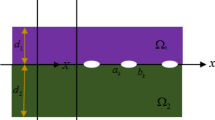Abstract
A bilayer beam model is extended to study the fracture behavior of dielectric interfacial cracks. In this model, a semi-infinite crack with an original opening value is oriented along the interface between two dielectric layers which are under mechanical/electrical loading. Taking into account the effect of the electrostatic traction on the interfacial crack, a nonlinear analytical solution is derived, along with also a developed finite element analysis method where a special constitutive equation for the capacitor element in ANSYS is utilized to simulate the electrostatic tractions. Both the analytical and numerical solutions predict the same results which further show that the elastic and dielectric mismatches can play a significant role in the interfacial cracking behavior under mechanical and electrical loading. Furthermore, the electrostatic tractions may cause hysteresis loops in the curve of crack opening versus applied mechanical displacement or versus applied electric voltage. An applied mechanical load is the driving force for the interfacial cracking, while an applied electric field retards it.













Similar content being viewed by others
References
ANSYS\({\textregistered }\) Academic Research, Release 11.0, Help System, Element Reference, TRANS126
England AH (1965) A crack between dissimilar media. J Appl Mech 32:400–402
Erdogan F (1965) Stress distribution in bonded dissimilar materials with cracks. J Appl Mech 36:650–652
Fan CY, Zhao MH, Meng LC et al (2011) On the self-consistent analysis, the energetically consistent approach, and electrostatic tractions in piezoelectric fracture mechanics. Eng Fract Mech 78:2338–2355
Gao CF, Tong P, Zhang TY (2004a) Effect of columbic force on piezoelectric fracture. Key Eng Mater 261–263:81–86
Gao CF, Zhao MH, Tong P et al (2004b) The energy release rate and the J-integral of an electrically insulated crack in a piezoelectric material. Int J Eng Sci 42:2175–2192
Hao TH, Shen ZY (1994) A new electric boundary condition of electric fracture mechanics and its applications. Eng Fract Mech 47:793–802
Hutchinson JW, Suo Z (1992) Mixed mode cracking in layered materials. Adv Appl Mech 29:63–191
Liechti KM, Chai YS (1990) Biaxial loading experiments for determining interfacial toughness. J Appl Mech 58:680–687
Landis CM (2004) Energetically consistent boundary conditions for electromechanical fracture. Int J Solids Struct 41:6291–6315
Li Q, Chen YH (2008) Why traction-free? Piezoelectric crack and coulombic traction. Arch Appl Mech 78:559–573
McMeeking RM (2004) The energy release rate for a Griffith crack in a piezoelectric material. Eng Fract Mech 71:1149–1163
Rice JR (1968) A path independent integral and approximation analysis of strain concentration by notches and cracks. J Appl Mech 35:379–386
Rice JR, Sih GC (1965) Plane problems of cracks in dissimilar media. J Appl Mech 32:418–423
Ricoeur A, Kuna M (2009) Electrostatic tractions at dielectric interfaces and their implication for crack boundary conditions. Mech Res Commu 36:330–305
Schneider GA (2007) Influence of electric field and mechanical sStresses on the fracture of ferroelectrics. Annu Rev Mater Res 37:491–538
Suo Z (1990) Singularities, interfaces and cracks in dissimilar anisotropic media. Proc R Soc Lond J Appl Mech 57:627–634
Suo Z, Hutchinson JW (1989) Interface crack between two elastic layers. Int J Fract 25:1337–1353
Suo ZG, Kuo CM, Barnett DM et al (1992) Fracture mechanics for piezoelectric ceramics. J Mech Phys Solids 40:739–765
Shapery RA, Davidson BD (1990) Prediction of energy release rate for mixed-mode delamination using classical plate theory. Appl Mech Rev 43:S281–S287
Tada H, Paris PC, Irwin GR (1985) The stress analysis of vracks handbook. Del Research, St. Louis, Missouri
Williams JG (1988) On the calculation of energy release rates for cracked laminates. Int J Fract 36:101–204
Xie T, Fan CY, Liu HT et al (2014) Effect of electrostatic tractions on the fracture behavior of a piezoelectric material under mechanical and/or electric loading. Theor Appl Fract Mech 69:6–16
Zhang TY, Gao CF (2004) Fracture behaviors of piezoelectric materials. Theor Appl Fract Mech 41:339–379
Zhang TY, Hack JE (1992) Mode III cracks in piezoelectric materials. J Appl Phys 71:5865–5870
Zhang TY, Qian CF, Tong P (1998) Linear electro-elastic analysis of a cavity or a crack in a piezoelectric material. Int J Solids Struct 35:2121–2149
Zhang TY, Xie T (2012) Effect of electrostatic tractions on the fracture behavior of a dielectric material under mechanical and/or electric loading. Sci China Technol Sci 55:2391–2403
Zhang TY, Zhao MH, Tong P (2002) Fracture of piezoelectric ceramics. Adv Appl Mech 38:147–289
Acknowledgments
The work was supported by the National Natural Science Foundation of China (No. 11102186, No. 11072221, No. 11172273) and by Henan Province through the Bairen Program. TY Zhang was supported by the general research grant 622610 from the Hong Kong Research Grants Council, Hong Kong, China. The authors thank Mr. T. XIE for helping check the equations in the paper.
Author information
Authors and Affiliations
Corresponding author
Rights and permissions
About this article
Cite this article
Zhao, M., Liu, H., Fan, C. et al. A nonlinear bilayer beam model for an interfacial crack in dielectric bimaterials under mechanical/electrical loading. Int J Fract 188, 47–58 (2014). https://doi.org/10.1007/s10704-014-9944-6
Received:
Accepted:
Published:
Issue Date:
DOI: https://doi.org/10.1007/s10704-014-9944-6




